Dynamic Wetland Evolution in the Upper Yellow River Basin: A 30-Year Spatiotemporal Analysis and Future Projections Under Multiple Protection Scenarios
Abstract
1. Introduction
2. Data and Methodology
2.1. Study Area
2.2. Data and Preprocessing
2.3. Methods
2.3.1. Statistical Analysis of Wetland Area Changes from 1990 to 2020
2.3.2. Patch-Generating Land Use Simulation Model (PLUS)
2.3.3. The Contribution Analysis of Influencing Factors
2.3.4. Analysis of Different Future Development Scenarios
2.3.5. Model Validation
3. Results
3.1. Changes in Wetland Area from 1990 to 2020
3.2. Typical Regional Wetland Changes
3.3. Wetland Type Changes from 1990 to 2020
3.4. Major Factors Affecting Wetland Changes
3.5. Simulation of Future Wetland Changes Under Multiple Scenarios
3.6. Simulation of Future Wetland Changes Under Multiple Scenarios in Typical Regional
4. Discussion
4.1. Analysis of Wetland Changes from 1990 to 2020
4.2. Future Changes in Wetlands in Typical Regions Under Multiple Scenarios
4.3. Limitations and Future Research
5. Conclusions
- (1)
- Over the past three decades, the wetland area in the upper Yellow River has shown a fluctuating growth trend, with the wetland area in 2020 increasing by 7.12% compared to 1990. However, there are significant differences in the area changes in different wetland types. The areas of rivers and canals and reservoirs increased substantially, by 26.39% and 57.97%, respectively; the area of paddy fields increased by 7.95%; and the area of nature water remained relatively stable, while the area of tidal flat decreased by 5.67%.
- (2)
- This study analyzed the contribution of eight types of influencing factors to the changes in five wetland types in the upper reaches of the Yellow River, revealing the dominant role of factors such as temperature, population density and DEM on wetland changes, especially the impact of temperature on paddy fields and canals, and the impact of population growth on changes in natural water and tidal flats.
- (3)
- The multi-scenario simulation results for future wetlands reveal the potential changes in wetlands under different land use policies and environmental conditions. Among them, the FPS and WPS scenarios achieve a relatively balanced approach between urbanization development and wetland protection, considering both the protection of wetland ecosystems and the needs of socioeconomic development.
Author Contributions
Funding
Data Availability Statement
Conflicts of Interest
References
- Mehvar, S.; Filatova, T.; Dastgheib, A.; De Ruyter van Steveninck, E.; Ranasinghe, R. Quantifying Economic Value of Coastal Ecosystem Services: A Review. J. Mar. Sci. Eng. 2018, 6, 5. [Google Scholar] [CrossRef]
- Cousens, R.; Mortimer, M. Dynamics of Weed Populations; Cambridge University Press: Cambridge, UK, 1995. [Google Scholar]
- Mao, D.; Wang, Z.; Wu, J.; Wu, B.; Zeng, Y.; Song, K.; Yi, K.; Luo, L. China’s wetlands loss to urban expansion. Land Degrad. Dev. 2018, 29, 2644–2657. [Google Scholar] [CrossRef]
- Gong, N.; Niu, Z.; Qi, W.; Zhang, H. Driving forces of wetland change in China. J. Remote Sens. 2016, 20, 172–183. [Google Scholar]
- Na, X.; Li, X.; Li, W.; Wu, C. Wetland mapping using HJ-1A/B hyperspectral images and an adaptive sparse constrained least squares linear spectral mixture model. Remote Sens. 2021, 13, 751. [Google Scholar] [CrossRef]
- Wang, X.; Xiao, X.; Xu, X.; Zou, Z.; Chen, B.; Qin, Y.; Zhang, X.; Dong, J.; Liu, D.; Pan, L.; et al. Rebound in China’s coastal wetlands following conservation and restoration. Nat. Sustain. 2021, 4, 1076–1083. [Google Scholar] [CrossRef]
- Hou, M.; Ge, J.; Gao, J.; Meng, B.; Li, Y.; Yin, J.; Liu, J.; Feng, Q.; Liang, T. Ecological risk assessment and impact factor analysis of alpine wetland ecosystem based on LUCC and boosted regression tree on the Zoige Plateau, China. Remote Sens. 2020, 12, 368. [Google Scholar] [CrossRef]
- Gao, L.; Tao, F.; Liu, R.; Wang, Z.; Leng, H.; Zhou, T. Multi-scenario simulation and ecological risk analysis of land use based on the PLUS model: A case study of Nanjing. Sustain. Cities 2022, 85, 104055. [Google Scholar] [CrossRef]
- Lee, J.; Cardille, J.A.; Coe, M.T. BULC-U: Sharpening resolution and improving accuracy of land-use/land-cover classifications in Google Earth Engine. Remote Sens. 2018, 10, 1455. [Google Scholar] [CrossRef]
- Mishra, V.N.; Rai, P.K.; Kumar, P.; Prasad, R. Evaluation of land use/land cover classification accuracy using multi-resolution remote sensing images. In Forum Geografic; Universitaria Publishing House: Craiova, Romania, 2016. [Google Scholar]
- Xu, X.; Liu, J.; Zhang, S.; Li, R.; Yan, C.; Wu, S. China Multi-Period Land Use Remote Sensing Monitoring Data Set (CNLUCC). Resource and Environmental Science Data Registration and Publishing System. 2020. Available online: https://www.resdc.cn/DOI/DOI.aspx?DOIID=54 (accessed on 11 January 2024).
- Yu, B.; Zang, Y.; Wu, C.; Zhao, Z. Spatiotemporal dynamics of wetlands and their future multi-scenario simulation in the Yellow River Delta, China. J. Environ. Manag. 2024, 353, 120193. [Google Scholar] [CrossRef]
- Farda, N. Multi-temporal land use mapping of coastal wetlands area using machine learning in Google earth engine. In IOP Conference Series: Earth and Environmental Science; IOP Publishing: Bristol, UK, 2017. [Google Scholar]
- Liang, X.; Guan, Q.; Clarke, K.C.; Liu, S.; Wang, B.; Yao, Y. Understanding the drivers of sustainable land expansion using a patch-generating land use simulation (PLUS) model: A case study in Wuhan, China. Comput. Environ. Urban Syst. 2021, 85, 101569. [Google Scholar] [CrossRef]
- Zheng, Z.; Wang, J.; Ni, J.; Cui, Y.; Zhu, Q. Lacustrine Wetlands Landscape Simulation and Multi-Scenario Prediction Based on the Patch-Generating Land-Use Simulation Model: A case study on shengjin lake reserve, China. Remote Sens. 2024, 16, 4169. [Google Scholar] [CrossRef]
- Sang, L.; Zhang, C.; Yang, J.; Zhu, D.; Yun, W. Simulation of land use spatial pattern of towns and villages based on CA–Markov model. Math. Comput. Model. 2011, 54, 938–943. [Google Scholar] [CrossRef]
- Fahad, K.H.; Hussein, S.; Dibs, H. Spatial-temporal analysis of land use and land cover change detection using remote sensing and GIS techniques. In IOP Conference Series: Materials Science and Engineering; IOP Publishing: Bristol, UK, 2020. [Google Scholar]
- Qi, D.; Li, G. Status, causes and protection countermeasures of wetland degradation in Maqu county in the Upper Yellow River. Wetl. Sci. 2007, 5, 341–347. [Google Scholar]
- Chen, Y.; Syvitski, J.P.M.; Gao, S.; Overeem, I.; Kettner, A. Socio-economic impacts on flooding: A 4000-year history of the Yellow River, China. Ambio 2012, 41, 682–698. [Google Scholar] [CrossRef]
- Qiao, Y.; Duan, Z. Understanding alpine meadow ecosystems. In Landscape and Ecosystem Diversity, Dynamics and Management in the Yellow River Source Zone; Springer: Cham, Switzerland, 2016; pp. 117–135. [Google Scholar] [CrossRef]
- Liu, J.; Kuang, W.; Zhang, Z.; Xu, X.; Qin, Y.; Ning, J.; Zhou, W.; Zhang, S.; Li, R.; Yan, C. Spatiotemporal characteristics, patterns, and causes of land-use changes in China since the late 1980s. J. Geogr. Sci. 2014, 24, 195–210. [Google Scholar] [CrossRef]
- Khiavi, H.T.; Mostafazadeh, R. Land use change dynamics assessment in the Khiavchai region, the hillside of Sabalan mountainous area. Arab. J. Geosci. 2021, 14, 2257. [Google Scholar] [CrossRef]
- Agarwal, C. A Review and Assessment of Land-Use Change Models: Dynamics of Space, Time, and Human Choice; USDA Forest Service: Washington, DC, USA, 2002. [Google Scholar]
- Cui, J.; Zhu, M.; Liang, Y.; Qin, G.; Li, J.; Liu, Y. Land use/land cover change and their driving factors in the Yellow River Basin of Shandong Province based on google earth Engine from 2000 to 2020. ISPRS Int. J. Geo-Inf. 2022, 11, 163. [Google Scholar] [CrossRef]
- Zhou, X.; Wu, D.; Li, J.; Liang, J.; Zhang, D.; Chen, W. Cultivated land use efficiency and its driving factors in the Yellow River Basin, China. Ecol. Indic. 2022, 144, 109411. [Google Scholar] [CrossRef]
- Hosmer, D.W., Jr.; Lemeshow, S.; Sturdivant, R.X. Applied Logistic Regression; John Wiley & Sons: Hoboken, NJ, USA, 2013. [Google Scholar]
- Liberti, L.; Lavor, C.; Maculan, N.; Mucherino, A. Euclidean distance geometry and applications. SIAM Rev. 2014, 56, 3–69. [Google Scholar] [CrossRef]
- Mao, D.; Luo, L.; Wang, Z.; Wilson, M.C.; Zeng, Y.; Wu, B.; Wu, J. Conversions between natural wetlands and farmland in China: A multiscale geospatial analysis. Sci. Total Environ. 2018, 634, 550–560. [Google Scholar] [CrossRef] [PubMed]
- Rounsevell, M.; Ewert, F.; Reginster, I.; Leemans, R.; Carter, T. Future scenarios of European agricultural land use: II. Projecting changes in cropland and grassland. Agric. Ecosyst. Environ. 2005, 107, 117–135. [Google Scholar] [CrossRef]
- Zedler, J.B. Progress in wetland restoration ecology. Trends Ecol. Evol. 2000, 15, 402–407. [Google Scholar] [CrossRef] [PubMed]
- Zhang, Y.; Jin, R.; Zhu, W.; Zhang, D.; Zhang, X. Impacts of land use changes on wetland ecosystem services in the Tumen River Basin. Sustainability 2020, 12, 9821. [Google Scholar] [CrossRef]
- Congalton, R.G. A review of assessing the accuracy of classifications of remotely sensed data. Remote Sens. Environ. 1991, 37, 35–46. [Google Scholar] [CrossRef]
- Mostern, R. The Yellow River: A Natural and Unnatural History; Yale University Press: London, UK, 2021. [Google Scholar]
- Burkett, V.; Kusler, J. Climate change: Potential impacts and interactions IN wetlands OF the untted states 1. JAWRA J. Am. Water Resour. Assoc. 2000, 36, 313–320. [Google Scholar] [CrossRef]
- Lafrenière, M.J.; Lamoureux, S.F. Effects of changing permafrost conditions on hydrological processes and fluvial fluxes. Earth-Sci. Rev. 2019, 191, 212–223. [Google Scholar] [CrossRef]
- Grant, K.; Finlayson, A.A. The assessment and evaluation of geotechnical resources in urban or regional environments. Eng. Geol. 1978, 12, 219–293. [Google Scholar] [CrossRef]
- Glicksman, R.L. Ecosystem resilience to disruptions linked to global climate change: An adaptive approach to federal land management. Neb. Law Rev. 2008, 87, 833. [Google Scholar]
- Boles, O.J.C.; Shoemaker, A.; Mustaphi, C.J.C.; Petek, N.; Ekblom, A.; Lane, P.J. Historical ecologies of pastoralist overgrazing in Kenya: Long-term perspectives on cause and effect. Hum. Ecol. 2019, 47, 419–434. [Google Scholar] [CrossRef]
- Ali, I.; Cawkwell, F.; Dwyer, E.; Barrett, B.; Green, S. Satellite remote sensing of grasslands: From observation to management. J. Plant Ecol. 2016, 9, 649–671. [Google Scholar] [CrossRef]
- Ballut-Dajud, G.A.; Herazo, L.C.S.; Fernández-Lambert, G.; Marín-Muñiz, J.L.; Méndez, M.C.L.; Betanzo-Torres, E.A. Factors affecting wetland loss: A review. Land 2022, 11, 434. [Google Scholar] [CrossRef]
- Wang, H.; Wu, X.; Bi, N.; Li, S.; Yuan, P.; Wang, A.; Syvitski, J.P.; Saito, Y.; Yang, Z.; Liu, S.; et al. Impacts of the dam-orientated water-sediment regulation scheme on the lower reaches and delta of the Yellow River (Huanghe): A review. Glob. Planet. Change 2017, 157, 93–113. [Google Scholar] [CrossRef]
- Zhang, K.-M.; Wen, Z.-G. Review and challenges of policies of environmental protection and sustainable development in China. J. Environ. Manag. 2008, 88, 1249–1261. [Google Scholar] [CrossRef]
- Verburg, P.H.; Eickhout, B.; Van Meijl, H. A multi-scale, multi-model approach for analyzing the future dynamics of European land use. Ann. Reg. Sci. 2008, 42, 57–77. [Google Scholar] [CrossRef]
- Liu, X.; Liang, X.; Li, X.; Xu, X.; Ou, J.; Chen, Y.; Li, S.; Wang, S.; Pei, F. A future land use simulation model (FLUS) for simulating multiple land use scenarios by coupling human and natural effects. Landsc. Urban Plan. 2017, 168, 94–116. [Google Scholar] [CrossRef]
- Guo, H.; Cai, Y.; Yang, Z.; Zhu, Z.; Ouyang, Y. Dynamic simulation of coastal wetlands for Guangdong-Hong Kong-Macao Greater Bay area based on multi-temporal Landsat images and FLUS model. Ecol. Indic. 2021, 125, 107559. [Google Scholar] [CrossRef]
- Xiang, H.; Wang, Z.; Mao, D.; Zhang, J.; Xi, Y.; Du, B.; Zhang, B. What did China’s National Wetland Conservation Program Achieve? Observations of changes in land cover and ecosystem services in the Sanjiang Plain. J. Environ. Manag. 2020, 267, 110623. [Google Scholar] [CrossRef]
- Pu, L.; Zhang, S.; Yang, J.; Yan, F.; Chang, L. Assessment of high-standard farmland construction effectiveness in liaoning province during 2011–2015. Chin. Geogr. Sci. 2019, 29, 667–678. [Google Scholar] [CrossRef]
- Zhang, C.; Robinson, D.; Wang, J.; Liu, J.; Liu, X.; Tong, L. Factors influencing farmers’ willingness to participate in the conversion of cultivated land to wetland program in Sanjiang National Nature Reserve, China. Environ. Manag. 2011, 47, 107–120. [Google Scholar] [CrossRef]
- Shi, J.; Zhang, P.; Liu, Y.; Tian, L.; Cao, Y.; Guo, Y.; Li, J.; Wang, Y.; Huang, J.; Jin, R.; et al. Study on spatiotemporal changes of wetlands based on PLS-SEM and PLUS model: The case of the Sanjiang Plain. Ecol. Indic. 2024, 169, 112812. [Google Scholar] [CrossRef]
- Liu, Z.; Guan, D.; Wei, W.; Davis, S.J.; Ciais, P.; Bai, J.; Peng, S.; Zhang, Q.; Hubacek, K.; Marland, G. Reduced carbon emission estimates from fossil fuel combustion and cement production in China. Nature 2015, 524, 335–338. [Google Scholar] [CrossRef]

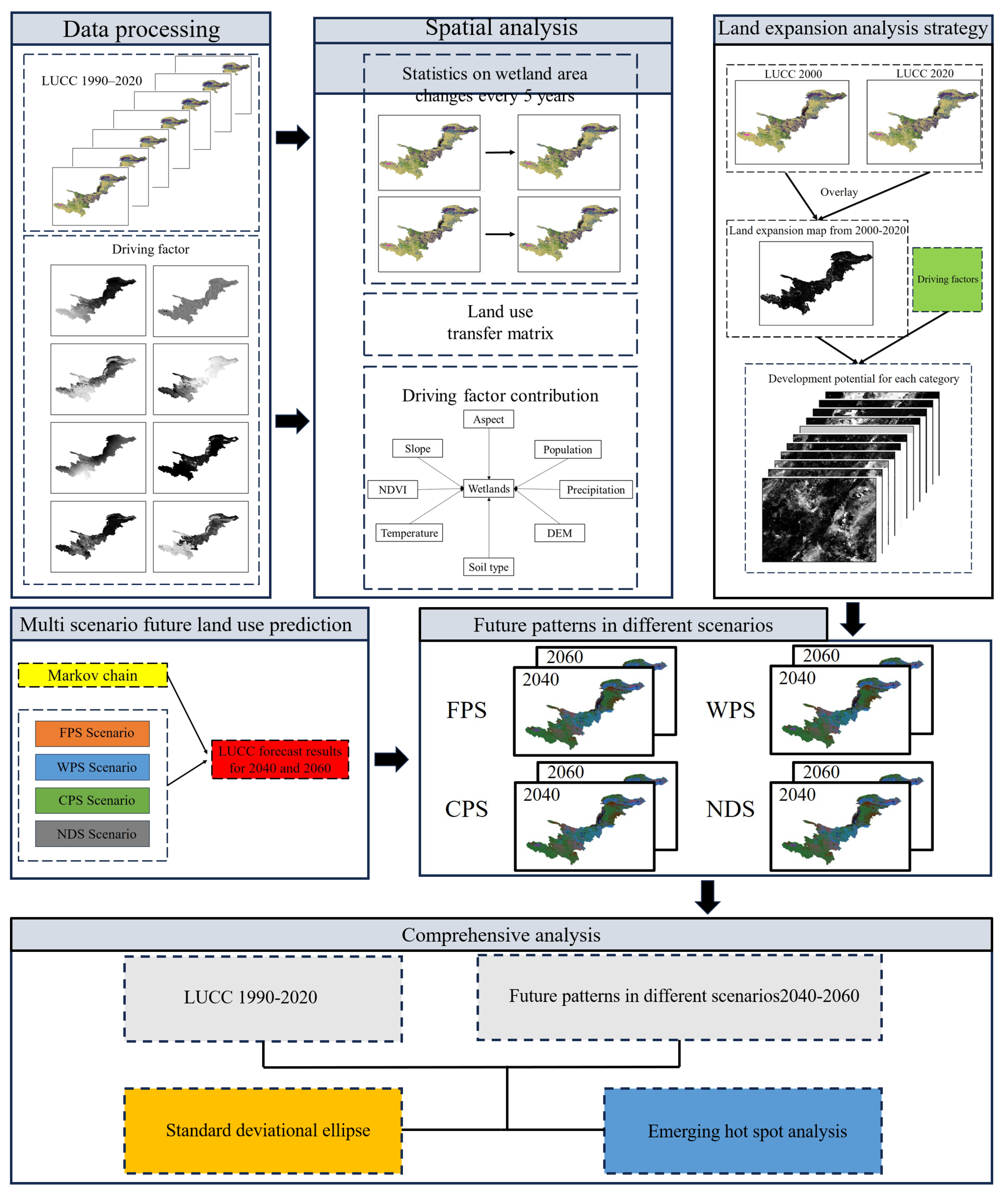

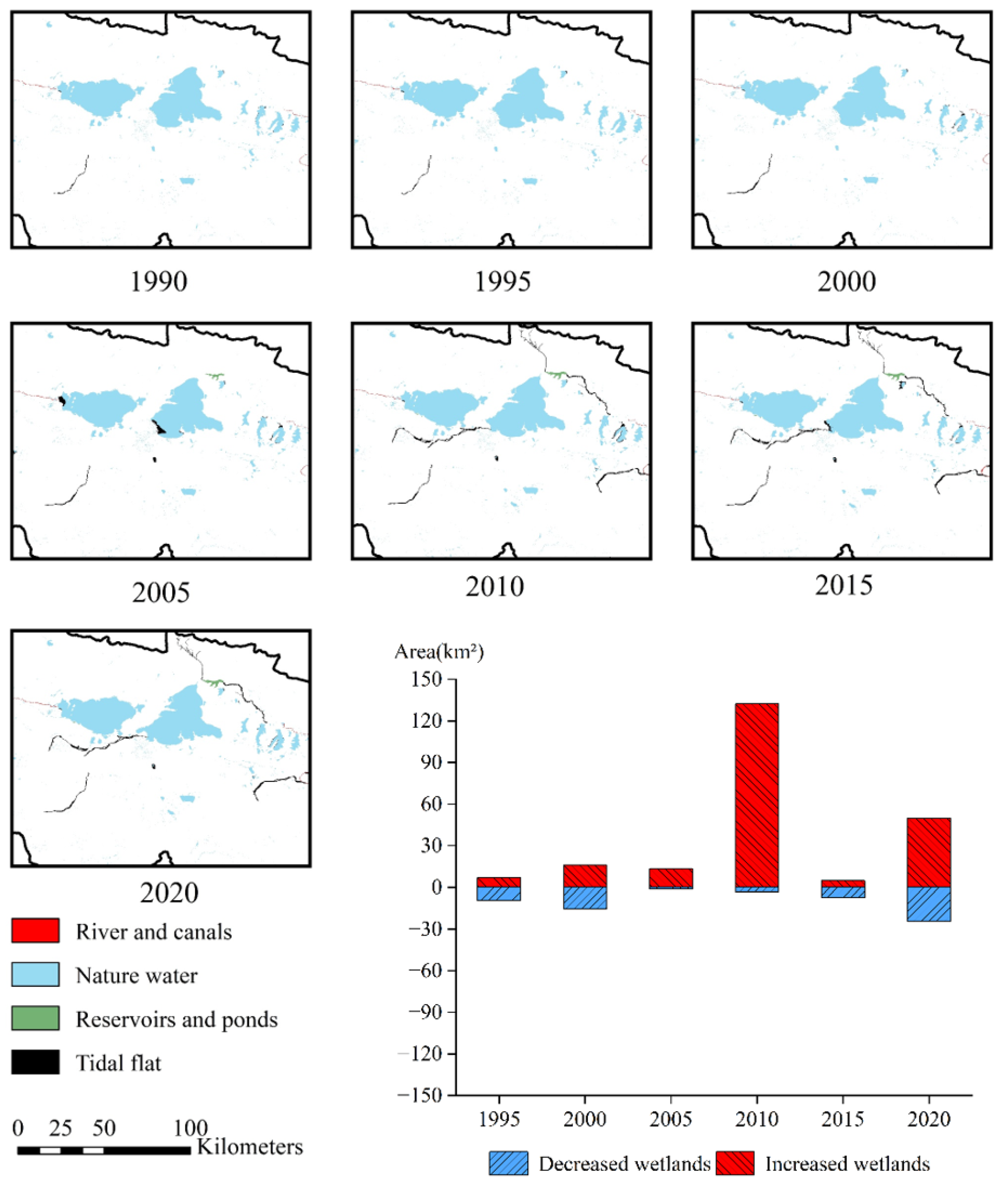
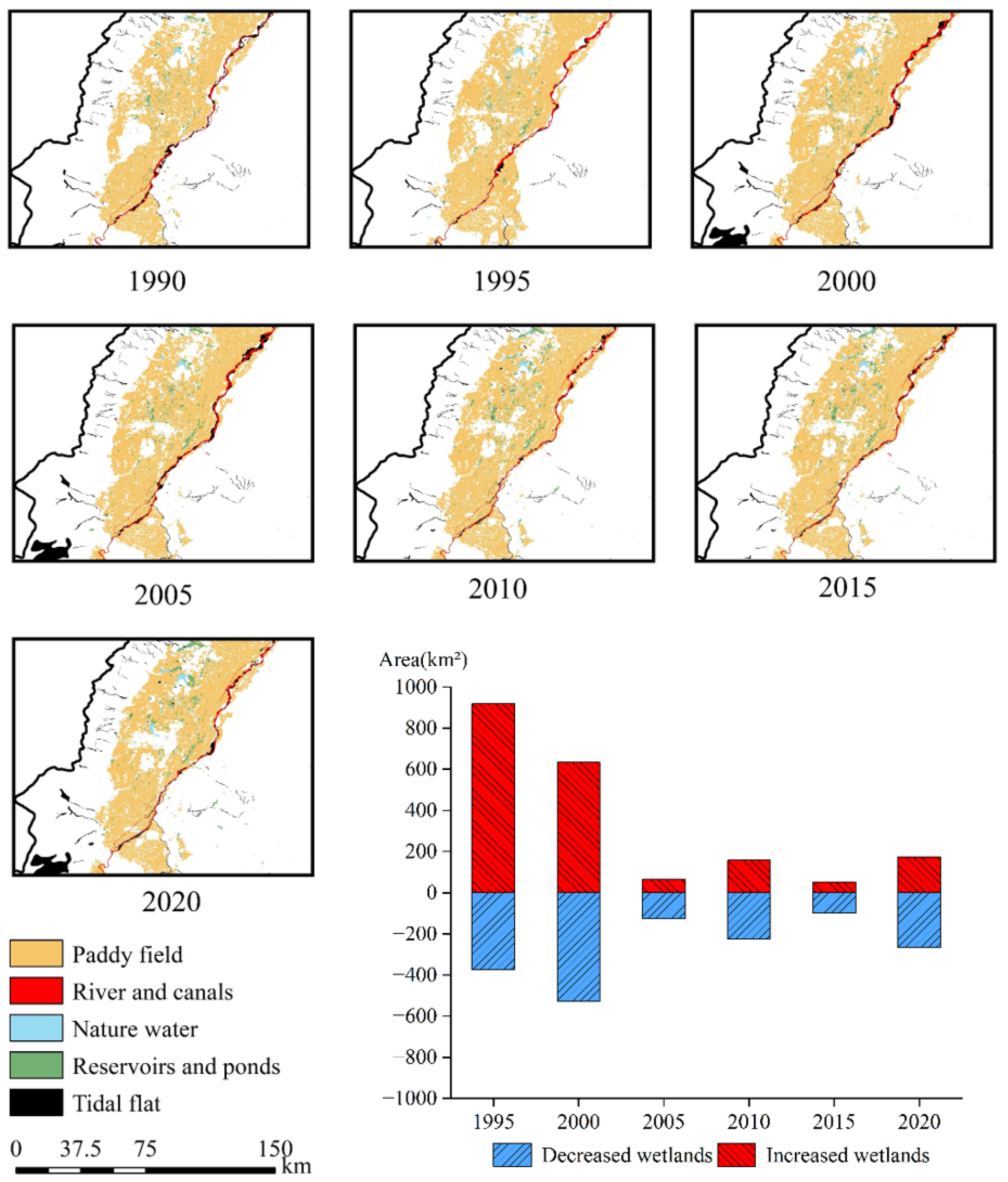
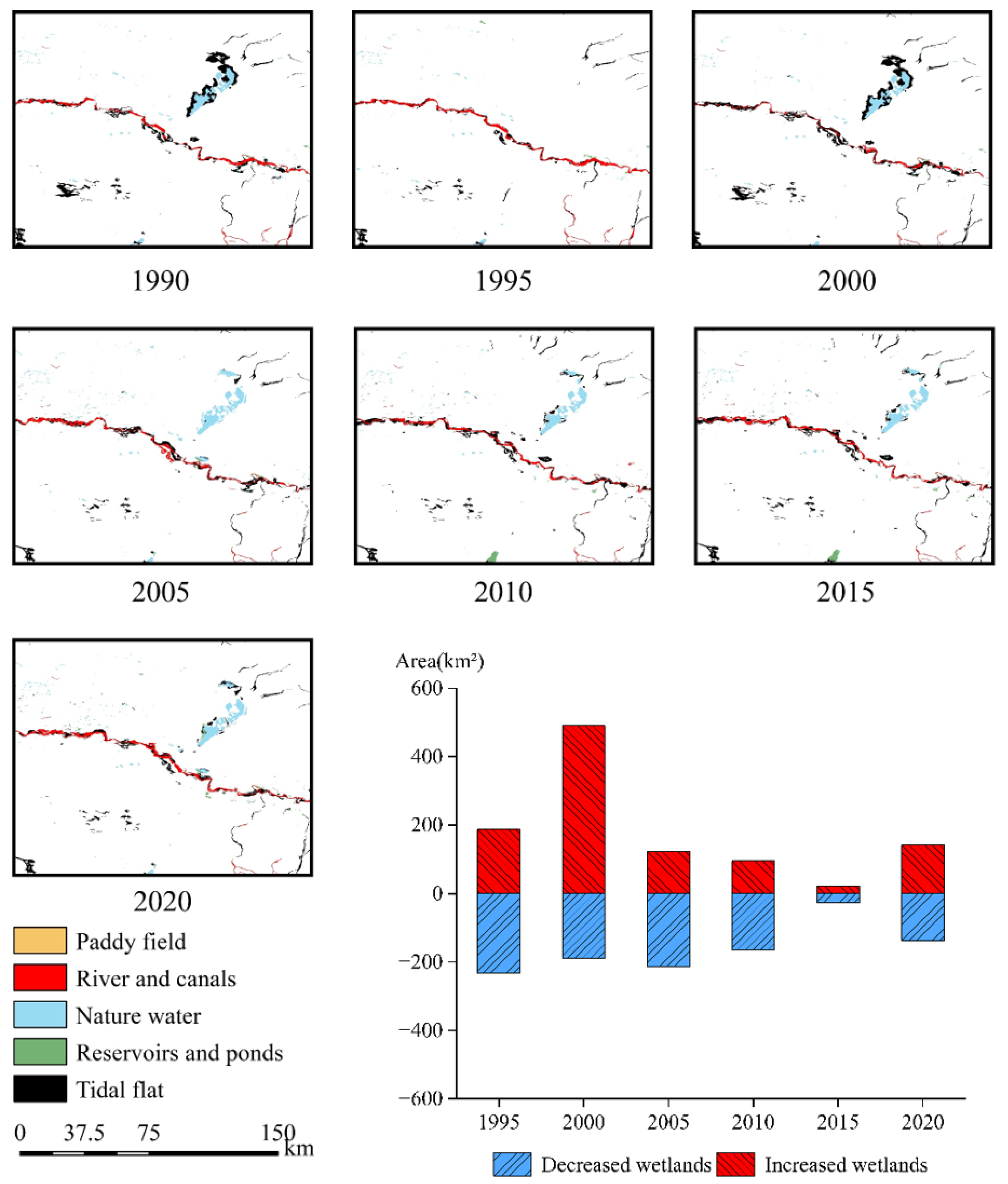
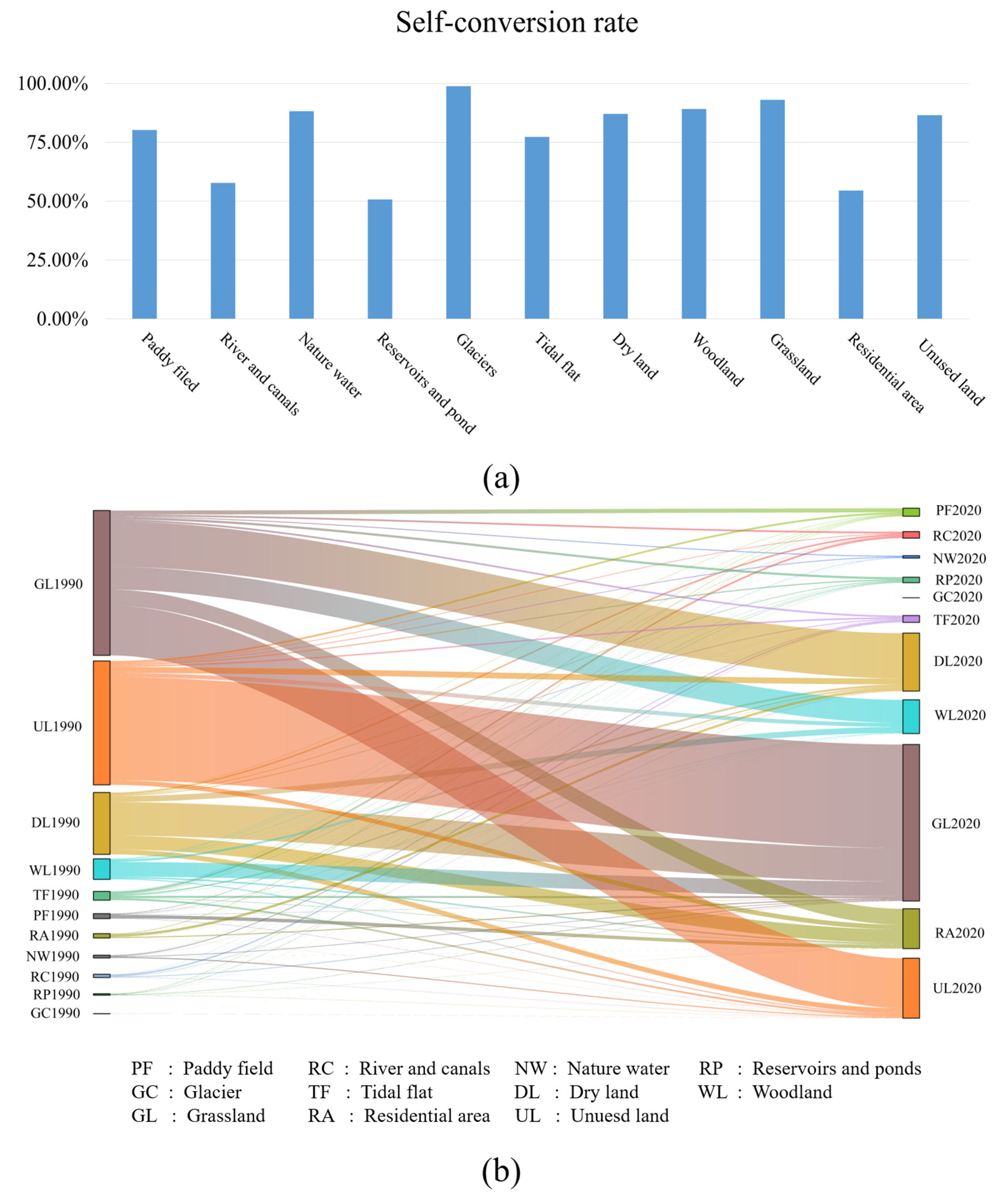

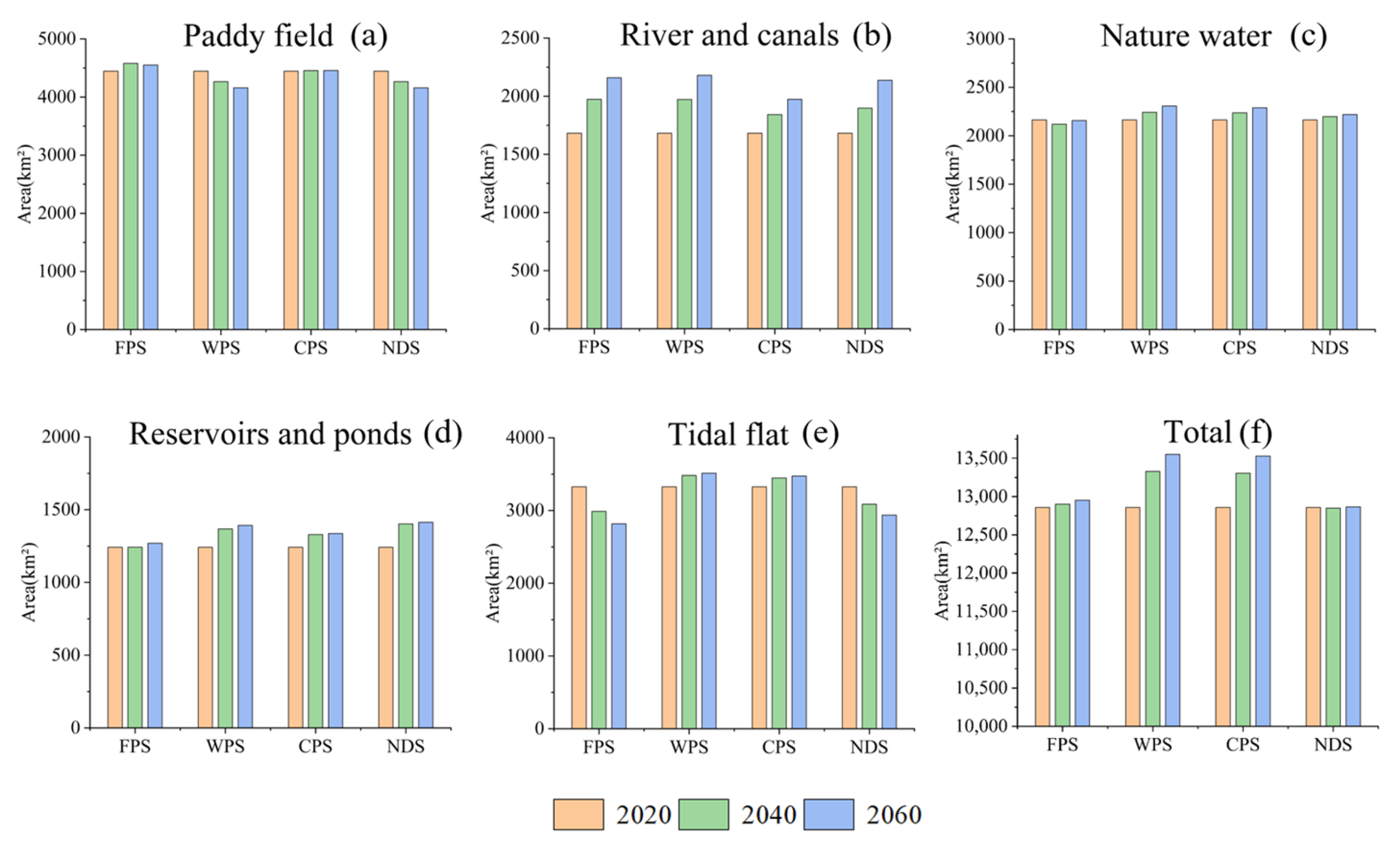
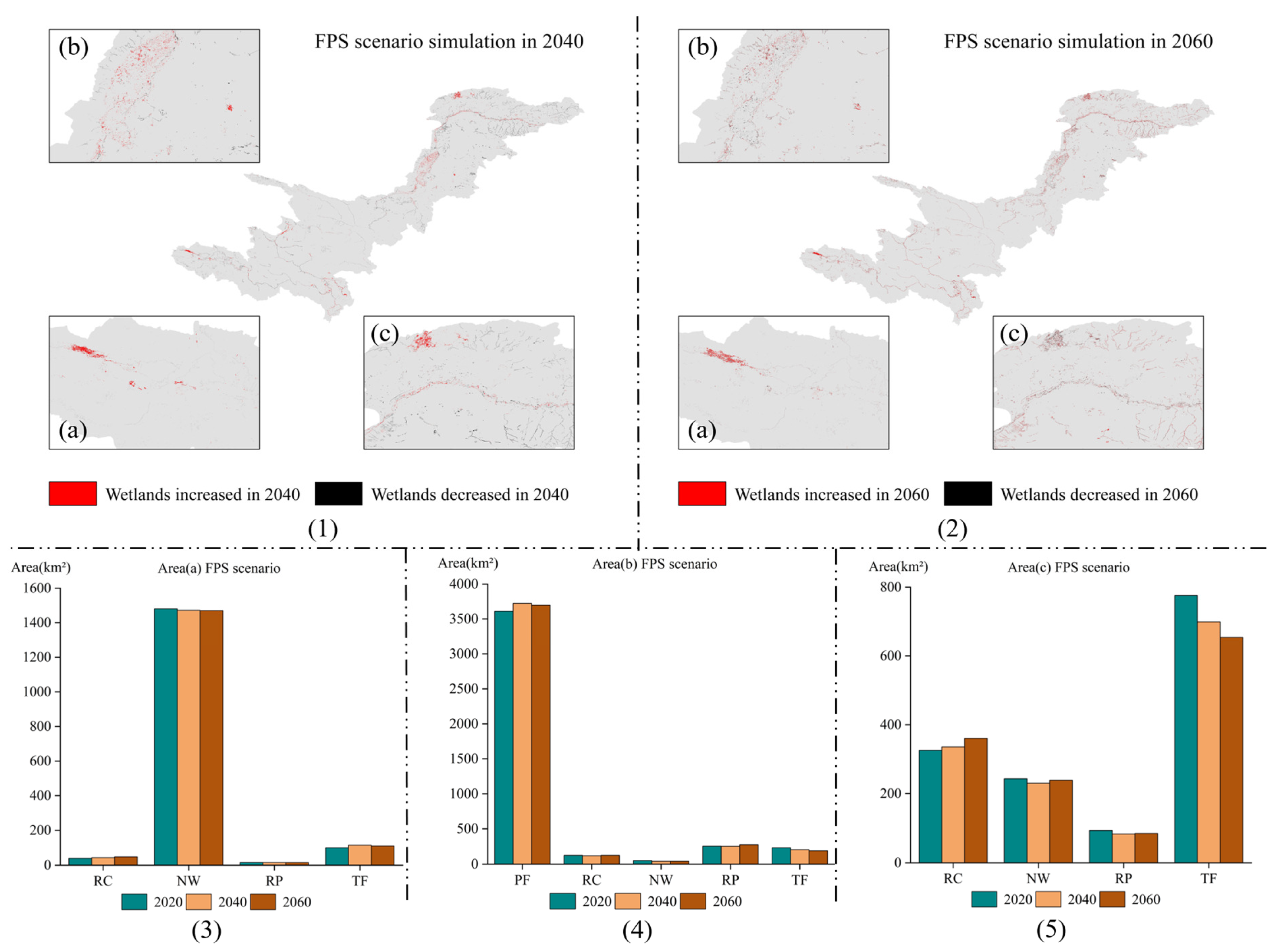
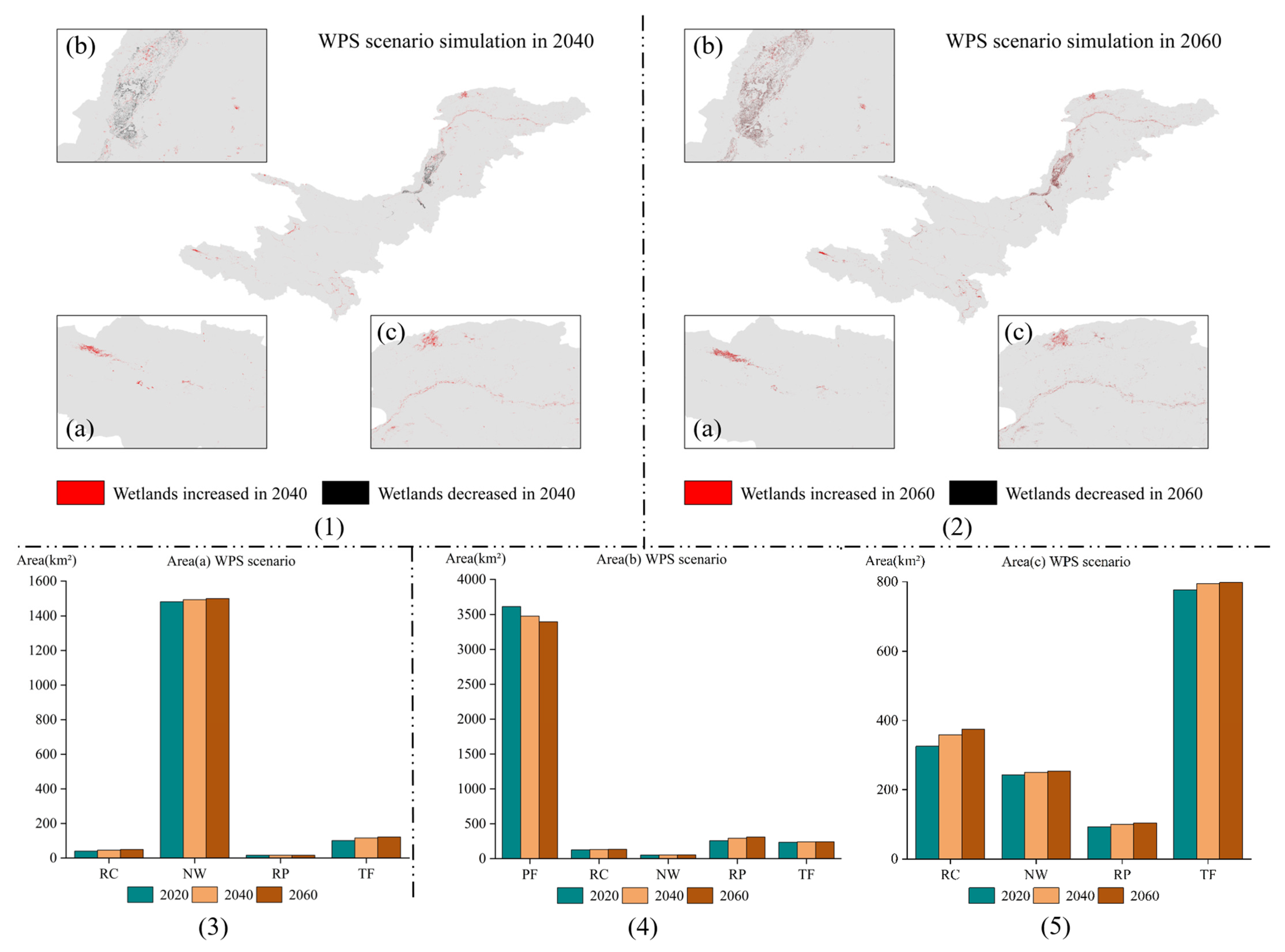
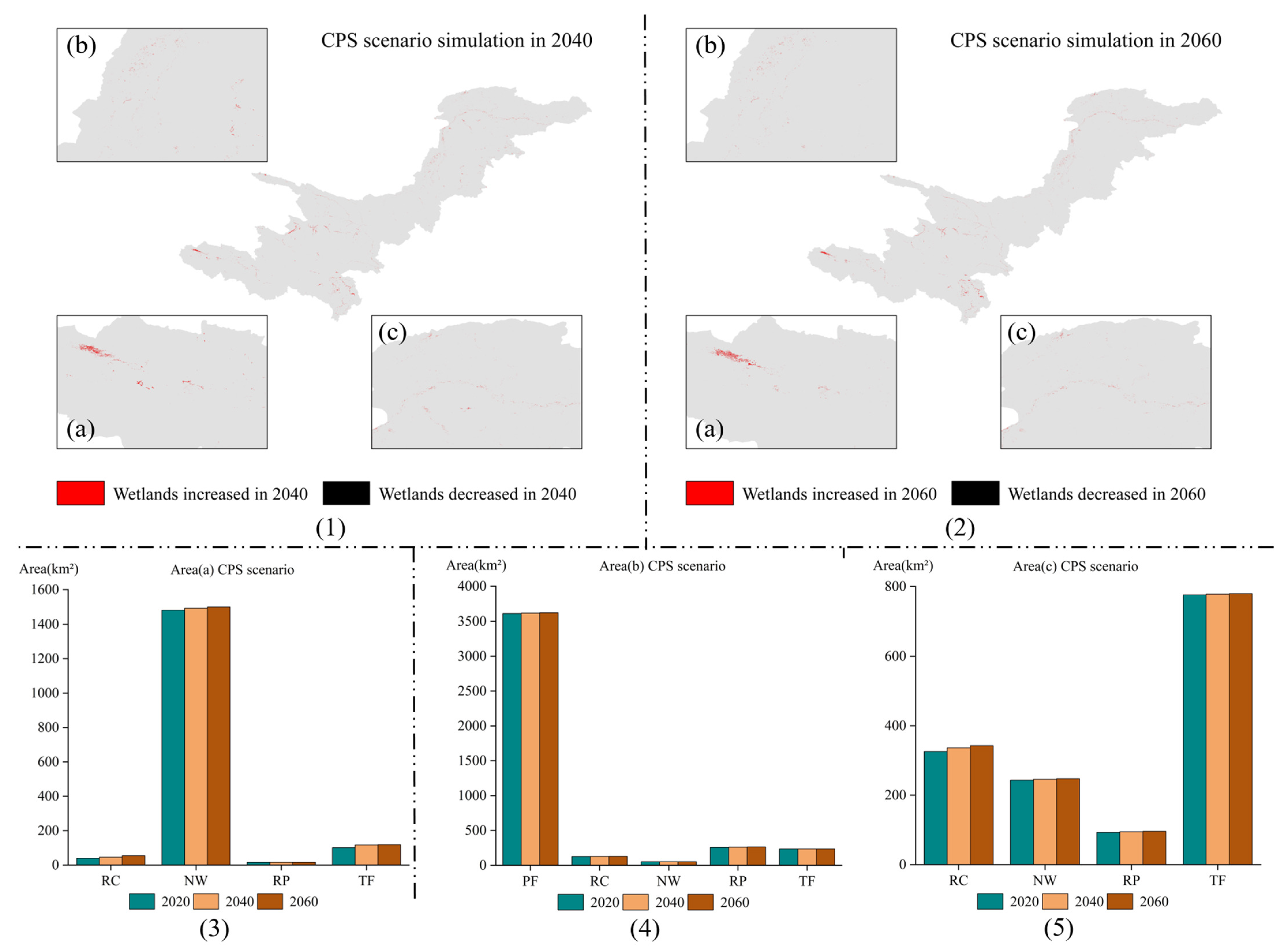
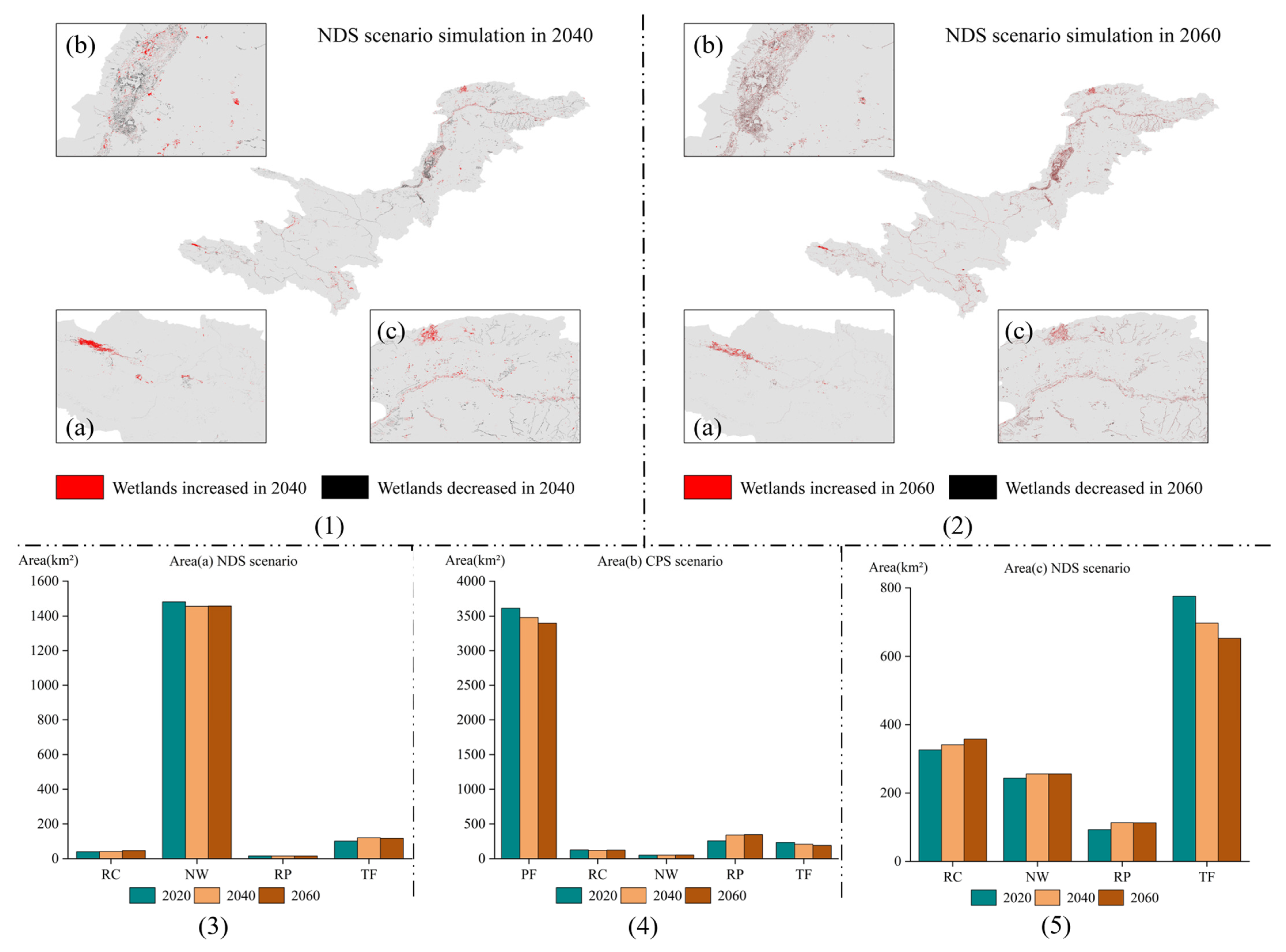
| Data | Resolution | Time | Source |
|---|---|---|---|
| LUCC | 30 m | 1990–2020 | http://www.geodata.cn/main/#/ (accessed on 19 June 2024) |
| DEM | 30 m | https://www.resdc.cn/User/UserEdit.aspx (accessed on 19 June 2024) | |
| Slope | 1 km | https://www.resdc.cn/User/UserEdit.aspx (accessed on 6 July 2024) | |
| Aspect | 1 km | https://www.resdc.cn/User/UserEdit.aspx(accessed on 6 July 2024) | |
| Population | 1 km | 1990–2020 | https://www.resdc.cn/User/UserEdit.aspx (accessed on 7 July 2024) |
| Temperature | 1 km | 1990–2020 | http://www.geodata.cn/main/#/ (accessed on 9 July 2024) |
| NDVI | 30 m | 1990–2020 | http://www.geodata.cn/main/#/ (accessed on 9 July 2024) |
| Soil type | 1 km | https://www.resdc.cn/User/UserEdit.aspx (accessed on 9 July 2024) | |
| Precipitation | 1 km | 1990–2020 | http://www.geodata.cn/main/#/ (accessed on 9 July 2024) |
| Area(km2)/Year | 1990 | 1995 | 2000 | 2005 | 2010 | 2015 | 2020 |
|---|---|---|---|---|---|---|---|
| Dry land | 50,024.1 | 50,526.2 | 50,822.2 | 49,796.7 | 52,802.4 | 52,618.5 | 49,634.1 |
| Woodland | 32,890.3 | 32,596.1 | 32,893.3 | 33,604.9 | 33,621.8 | 33,611.1 | 34,337.2 |
| Grassland | 246,643.4 | 247,379.7 | 244,728.2 | 243,141.5 | 246,177.6 | 245,976.6 | 247,866.3 |
| Residential area | 5718.1 | 6011.6 | 6011.3 | 6483.1 | 7165.9 | 7888.9 | 9599.6 |
| Unused land | 55,990.5 | 55,096.6 | 56,182.3 | 57,704.8 | 50,851.2 | 50,540.6 | 48,926.3 |
| Contribution | Aspect | DEM | NDVI | Popularity | Precipitation | Slope | Soiltype | Temperature |
|---|---|---|---|---|---|---|---|---|
| Paddy field | 0.014 | 0.179 | 0.061 | 0.159 | 0.161 | 0.028 | 0.104 | 0.294 |
| Rivers and canals | 0.012 | 0.230 | 0.060 | 0.157 | 0.152 | 0.025 | 0.115 | 0.248 |
| Nature water | 0.008 | 0.179 | 0.088 | 0.286 | 0.126 | 0.013 | 0.143 | 0.154 |
| Reservoirs and ponds | 0.016 | 0.202 | 0.071 | 0.168 | 0.192 | 0.026 | 0.129 | 0.193 |
| Tidal flat | 0.012 | 0.167 | 0.072 | 0.209 | 0.180 | 0.027 | 0.130 | 0.203 |
| Dry land | 0.012 | 0.167 | 0.072 | 0.209 | 0.180 | 0.027 | 0.130 | 0.203 |
| Woodland | 0.013 | 0.189 | 0.049 | 0.183 | 0.189 | 0.033 | 0.134 | 0.208 |
| Grassland | 0.015 | 0.154 | 0.054 | 0.170 | 0.169 | 0.086 | 0.135 | 0.215 |
| Residential area | 0.013 | 0.213 | 0.047 | 0.181 | 0.183 | 0.031 | 0.119 | 0.210 |
| Unused land | 0.012 | 0.202 | 0.034 | 0.238 | 0.147 | 0.042 | 0.093 | 0.230 |
Disclaimer/Publisher’s Note: The statements, opinions and data contained in all publications are solely those of the individual author(s) and contributor(s) and not of MDPI and/or the editor(s). MDPI and/or the editor(s) disclaim responsibility for any injury to people or property resulting from any ideas, methods, instructions or products referred to in the content. |
© 2025 by the authors. Licensee MDPI, Basel, Switzerland. This article is an open access article distributed under the terms and conditions of the Creative Commons Attribution (CC BY) license (https://creativecommons.org/licenses/by/4.0/).
Share and Cite
Liu, Z.; Huang, C.; Zhou, T.; Feng, T.; Bie, Q. Dynamic Wetland Evolution in the Upper Yellow River Basin: A 30-Year Spatiotemporal Analysis and Future Projections Under Multiple Protection Scenarios. Land 2025, 14, 1219. https://doi.org/10.3390/land14061219
Liu Z, Huang C, Zhou T, Feng T, Bie Q. Dynamic Wetland Evolution in the Upper Yellow River Basin: A 30-Year Spatiotemporal Analysis and Future Projections Under Multiple Protection Scenarios. Land. 2025; 14(6):1219. https://doi.org/10.3390/land14061219
Chicago/Turabian StyleLiu, Zheng, Chunlin Huang, Ting Zhou, Tianwen Feng, and Qiang Bie. 2025. "Dynamic Wetland Evolution in the Upper Yellow River Basin: A 30-Year Spatiotemporal Analysis and Future Projections Under Multiple Protection Scenarios" Land 14, no. 6: 1219. https://doi.org/10.3390/land14061219
APA StyleLiu, Z., Huang, C., Zhou, T., Feng, T., & Bie, Q. (2025). Dynamic Wetland Evolution in the Upper Yellow River Basin: A 30-Year Spatiotemporal Analysis and Future Projections Under Multiple Protection Scenarios. Land, 14(6), 1219. https://doi.org/10.3390/land14061219










